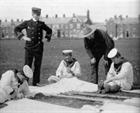On this day 12 March 1903
On this day 12 March 1903 Admiralty investigates kites for spotting.
Samuel Franklin Cody, an American, was an early pioneer of manned flight, most famous for his work on the large kites known as Cody kites. A large exhibition of the Cody kites took place at Alexandra Palace in 1903. His exploits came to the attention of the Admiralty and a series of Naval Kite Trials were held.
On Woolwich Common on the 12 and 13 March 1903, Cody flew his eight ft. black silk kite and his seventeen ft. calico man lifter watched by representatives of the Admiralty. Captain Reginald Tupper (Assistant Director of Naval Ordnance) wrote in his report of the display – ‘This is quite the best kind of kite I have seen, and I have every reason to think it will be of use for supporting an aerial wire for W/T purposes, and that it can easily be handled and flown from the deck of a ship or even small craft. I have no hesitation in recommending a trial.’ The interest of Prince Louis of Battenburg, the Director of Naval Intelligence was engaged and he proposed that kite tests should be carried out for the purposes of ‘a) Lifting an aerial wire for [wireless] telegraphy both ashore and afloat and b) Lifting a man to a considerable height from a ship under weigh for reconnoitring purposes.’
Cody and his team arrived in Portsmouth on the 29 March and trials began on the following day at the RN Gunnery Training School (HMS Excellent) on Whale Island in Portsmouth Harbour. Two days of land based trials on the island were followed by three days of shipboard trials, initially in harbour in the old ironclad Hector and later, at sea, in the destroyer Starfish. At this time Hector formed part of HMS Vernon – the Royal Navy’s torpedo school which, apart from its normal duties, was presently engaged in the development of wireless telegraphy. Consequently, these later tests concentrated on the possible use of kites for the lifting of wireless aerials for long range communication but also included trials for visual signalling. The tests were concluded on the 4 April with additional flights from Whale Island. A very favourable report was issued on these trials which included the comment that Cody’s kites… ‘are immensely superior to any kites previously tried here.’ A second week of trials concentrating on man lifting for aerial observation began on the 13 April with a flight from Whale Island.
In 1908 the Navy again asked Cody to take part in kite trials at Portsmouth. The timing was somewhat inconvenient because Cody was just in the process of putting the finishing touches to his Army Aeroplane No 1a. In May two Petty Officers and four leading seamen had arrived at Farnborough to embark on a training course under Cody. No record has been found on the nature of this training but photographic evidence shows them helping him with his unfinished aeroplane.
The seagoing trials began on 17 August and between that date and 7 October kites were flown on nineteen days. The ships employed were the battleship Revenge, the cruiser Grafton and the destroyers Fervent and Recruit. The purpose of these trials was to test the practical applications of man lifting kites for naval purposes i.e. signalling, photography, detection of underwater objects, general observation and the spotting of gunfire. Detailed daily reports were kept and the report for the 31 August is particularly interesting. On this day a flight was made from HMS Recruit, to determine if mines could be detected from the air. The kite basket, with Cody in it, was at a height of about 800 feet when the carrier and then the lifter kites suddenly took a dive to the right. They all recovered but then dived again and the basket hit the water and turned over. Cody dived out and held onto the basket for support. The destroyer had meanwhile turned back and soon picked him up, none the worse for his ducking. Two days later Cody was back in the air but this time suspended not in a basket but in a breeches buoy. Among the experiments carried out was one to establish if a breeches buoy would float with a man in it – the volunteer for this was most probably Cody. This test proved successful but as it was thought the buoy was capable of being capsized, a little lead was put in each foot. He flew off the deck of battleship HMS Revenge on 2 September 1908. On 4 September Cody returned to Farnborough, where his aeroplane was nearing completion, but he returned to Portsmouth once more on the 30 September for the last week of seagoing trials. The last trial with Cody present took place on the 7 October and later trials took place without him. Four sets of his kites were ordered by the Admiralty.
His kite designs were not subsequently used by the Admiralty though hybrid kite-balloons (a spherical balloon with a kite attached to the upper hemisphere to aid steering and stability) were later developed and used. Kite-balloons were used in the Dardanelles spotting for naval guns, the first ship carrying a kite-balloon being HMS Manica in April 1915 and then HMS Hector in June 1915.
Cody was also involved with the development of gliders, dirigibles and airplanes for the Army. His flight in British Army Aeroplane No.1 on 5 October 1908 is recognised as the first official flight of a piloted heavier than air machine in Great Britain.
The image (©FAAM) shows what a man-lifting kite looked like when deployed. The Fleet Air Arm Museum has in its collection both an original and a replica Cody kite.
Much of the information in this article comes from this excellent site on SF Cody.


